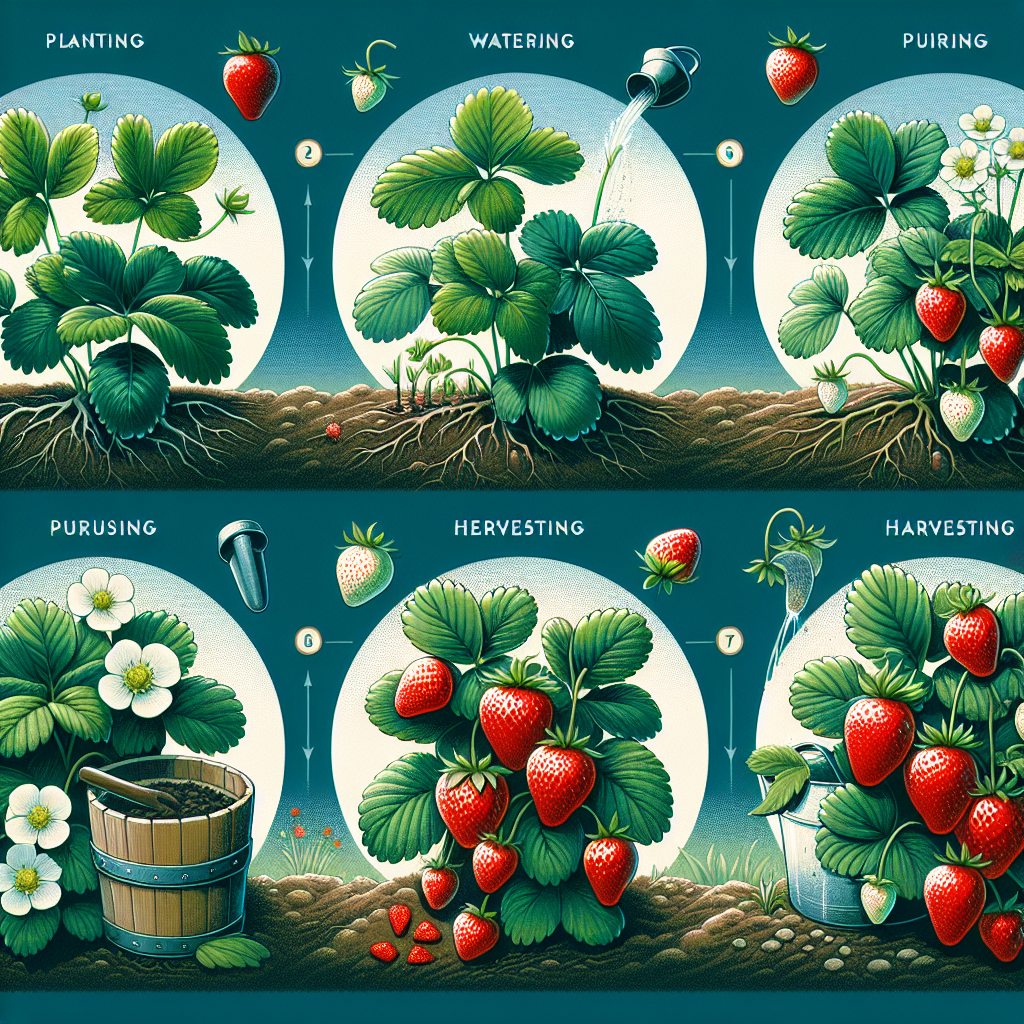Stopping Cabbage Worms in Vegetable Gardens
Updated May 11, 2024 at 4:58 am
Discover effective strategies for protecting your vegetable garden from the relentless munching of cabbage worms, ensuring your cabbages and other leafy greens can thrive without these pesky invaders.

“`html
Overview of Cabbage Worm Management
- Pet Friendly: Most natural remedies and manual methods are safe around pets.
- Chemical Use: Keep to a minimum to protect beneficial insects and the environment.
- Integrated Pest Management: Combines cultural, physical, and, when necessary, chemical methods for a balanced approach.
- Prevention: Regular inspections and early intervention are key to control.
- Difficulty: With the right strategies, manageable for gardeners of all levels.
Understanding the Enemy: Cabbage Worm Identification
If you've spotted irregular holes and chewed edges on your cabbages, broccoli, or kale, it could well be the work of the cabbage worm. Pinpointing your adversary is crucial. The so-called cabbage worm is usually the larva of the cabbage white butterfly (Pieris rapae), which are a soft, velvety green with faint yellow stripes down their back and sides.
Despite their benign appearance, these grubs are voracious feeders. Grasping their behavior and life cycle is pivotal for your garden's defense. Female butterflies lay eggs on the underside of leaves, which hatch into the larvae that wreak havoc on your vegetables.
Physical Barriers: The First Line of Defense
Let's start with the fundamentals: physical barriers. Neoteric gardeners might not know about the efficacy of row covers, but they're a simple and effective deterrent. Row covers, such as lightweight, translucent fabrics, can be placed over your vegetables to prevent butterflies from laying eggs.
Secure the edges to ensure no gaps and remove during flowering if you're growing crops that require pollination. It's a hassle-free method that circumvents the need for chemicals. This way, you can enjoy your leafy greens knowing there's been minimal intervention.
Organic Solutions: Navigating Natural Remedies
When looking for treatments, organic solutions are often advised. BT (Bacillus thuringiensis) is a naturally occurring bacteria that's harmless to humans and pets but lethal to caterpillars. This microbial insecticide can be sprayed directly onto the foliage. Once ingested by the cabbage worm, the bacteria produce proteins that target the caterpillar's digestive system, causing them to stop feeding and eventually die.
BT products are widely available under various brand names, and their use has been reviewed as favorable among organic gardening circles. When utilizing BT, follow the application instructions carefully. Although it's accepted in organic farming, it's wise to use it judiciously to avoid resistance in pests and conserve beneficial insect populations.
Attracting Beneficial Insects: Nature's Pest Control
Besides plants themselves, your garden is home to a myriad of insects, some of which are natural predators to the cabbage worm. Creating a pollinator-friendly vegetable garden is not only great for the environment but also brings in allies such as wasps, ladybugs, and ground beetles that feed on the eggs and larvae of the cabbage white butterfly.
Incorporate flowering plants that attract these beneficial insects amongst your vegetables. For instance, dill, fennel, and coriander are known to entice predatory wasps, which will help keep the cabbage worm population in check. It's a win-win; you will be supporting biodiversity while naturally maintaining pest levels.
Manual Intervention: Hands-On Tactics
If you're not squeamish, manual removal of eggs and larvae can be incredibly effective — though admittedly labor-intensive. This involves regular scanning of your plants for the tell-tale eggs and caterpillars. If detected, you can simply squash the eggs and pick off the larvae by hand.
Maintaining vigilance is a task, but it's a completely non-toxic, cost-free method. It's said that this hands-on approach not only helps control pest populations but also deepens your connection to, and knowledge of, your garden.
Chemical Conundrums: When to Consider Pesticides
While organic and physical methods are preferable, there might come a time when chemical intervention seems necessary. When considering this route, choosing the least harmful option is essential. Pyrethrin-based insecticides can be used sparingly to tackle severe infestations but remember, they don't discriminate between beneficial insects and pests.
Pyrethrin, derived from the chrysanthemum plant, attacks the nervous system of insects on contact. Although deemed less harmful than other chemical pesticides, its application should be closely managed and timed not to affect honeybees and other pollinators.
Monitoring and Timing: The Key to Successful Control
Understanding the lifecycle of the cabbage worm and closely monitoring your plants is a solid strategy. The key times to be vigilant are early spring and again in late summer, which typically correspond to the reproductive cycles of the cabbage white butterfly.
By timing your preventive measures, such as application of BT or release of beneficial insects, to coincide with these cycles, you can significantly reduce the cabbage worm population.
“`
“`html
Cultural Practices: Cultivating a Hostile Environment for Pests
Aside from ensuring a diverse population of helpful insects, embedding sound cultural practices into your garden routine can create conditions unfavorable for cabbage worms. Crop rotation is a critical technique, limiting their access to their favorite plants by switching up their location each season.
This practice not only deters pest buildup but also enhances soil health, thereby promoting stronger, more resilient plants. It’s a strategy that can save significant time and energy later on, by preventing problems before they arise.
Sanitation: Keeping the Garden Clean
Maintaining cleanliness in the garden is more than aesthetics; it’s about pest management. Removing plant debris and spent crops promptly can eliminate potential cabbage worm shelters and food sources. Without a convenient place to hide or feast, the life cycle of these pests can be disrupted.
Essentially, good sanitation equates to a less hospitable environment for pests and a healthier garden overall. Be thorough and consistent, and you’ll likely see the benefits in the reduced presence of cabbage worms.
Companion Planting: Strategic Alliances in the Garden
Companion planting is another natural strategy to consider; it’s about aligning with nature to protect your crops. Some plants emit scents or possess traits that naturally repel pests, including cabbage worms. Marigolds, thyme, and sage, when planted amongst your vegetables, can play a dual role of beautification and biological warfare.
Not only can they help to ward off cabbage worms by their presence alone, but they also attract beneficial insects, making them an excellent addition to any vegetable garden.
Choosing the Right Variety: Fortifying Your Garden Naturally
Did you know some vegetable varieties are naturally more resistant to pests? Savvy gardeners swear by choosing the right cultivars that come with built-in defenses against cabbage worms. For example, some types of cabbage come with a thicker wax coat on their leaves, which caterpillars find less palatable.
Researching and planting these resistant varieties can be a game-changer in your quest to maintain a healthy garden. It’s a smart initial step that could pay off considerably in reducing the need for intervention later on.
Traps and Bait: Outsmarting Cabbage Worms
Trapping is an age-old technique that can still work wonders. Yellow sticky traps can catch cabbage white butterflies before they have a chance to lay eggs. Placing them strategically around the perimeter of your vegetable patch can reduce the amount of egg-laying within your greens.
Additionally, DIY bait traps made from fermented fruit juice can attract and drown adult butterflies. This method is often lauded for its inventiveness and effectiveness by garden enthusiasts.
Keeping a Detailed Journal: Track Progress and Patterns
One of the best tools in your arsenal might just be a simple notebook. Keeping a garden journal where you track sightings, interventions, and weather patterns can provide invaluable insights into the patterns and behavior of cabbage worms.
Not only does this make you more attuned to what’s happening in your garden, it allows you to apply treatments more precisely and efficiently. Sharing your observations with fellow gardeners can also help build a community of support and shared learning.
Utilizing Technology: The Modern Gardener’s Toolkit
In an age where technology touches all aspects of life, why not gardening? There are various apps and online forums where you can track pest sightings regionally, allowing you to pre-empt potential outbreaks in your area.
Combining modern tools with time-honored gardening practices not only makes for a sophisticated defense against cabbage worms but also enriches the overall gardening experience with community and shared problem-solving.
When to Harvest: Minimizing Pest Damage
Timely harvesting plays an unforeseen role in pest control. Cabbage worms have a feasting window, and by harvesting your crops just a tad earlier, you may avoid peak infestation periods.
This strategy not only secures your efforts throughout the growing season but also ensures that the fruits of your labor are worm-free and ready for the kitchen. Advice on harvesting techniques and timing can be gleaned from resources like the comprehensive guide on harvesting tips.
Reflective Mulches: A Bright Idea for Pest Control
Who would have thought that a little shimmer could act as a pest deterrent? Reflective mulches, such as aluminum foil or a reflective plastic, can disorient and ward off cabbage white butterflies looking for a place to lay their eggs.
Applied to the garden’s soil surface, they not only confuse pests but can also increase the amount of light available to the plants and help retain soil moisture. It’s a simple yet ingenious solution to consider in your battle against cabbage worms.
Decoy Plants: Sacrificing for the Greater Good
Sometimes, the best line of defense is a good decoy. Certain plants, known as trap crops, can be grown to attract pests away from your main vegetable crop. Nasturtiums, for instance, can be more appealing to cabbage worms than your vegetables and when placed strategically, can act as a catch basin for the pests.
Being proactive and planting these decoys can serve as a first strike against cabbage worm infestation, minimizing damage to the plants you care about most.
Pros and Cons of Using Diatomaceous Earth
Pros
- Natural and non-toxic to humans and pets
- Effective as a physical insecticide due to its abrasive properties
- Easy to apply around the base of plants
Cons
- Has to be reapplied after rainfall or irrigation
- Can also affect beneficial insects if not applied carefully
- Fine dust can be an irritant when inhaled, so caution is necessary during application
Diatomaceous earth can be quite the ally in your fight against common garden pests like cabbage worms. It’s a powdery, natural substance made from crushed fossils of freshwater organisms and marine life, and it works by cutting through the protective outer layer of insects.
Applying a ring of diatomaceous earth around your susceptible plants creates a barrier that’s quite formidable for soft-bodied insects. Make sure to use food-grade diatomaceous earth, which is recommended for use around edibles. Your local garden community might have suggestions for the best brands, or you can research online reviews for users’ experiences with products like Harris Diatomaceous Earth or Safer Brand.
Find This and More on Amazon
“““html
Engaging the Community: Sharing Strategies and Successes
Community input can be indispensable. Engaging with local gardening clubs or online forums can provide a wealth of knowledge and shared experiences. Many gardeners are eager to share what has worked in their battle against cabbage worms.
Attending local workshops or collaborative gardening days can also lead to hands-on learning and direct advice for managing pests in your area. Plus, it’s a chance to connect with like-minded individuals passionate about sustainable gardening.
Water Management: Staying Dry to Keep Worms Away
Avoiding excessive moisture can play a critical role in pest deterrence. Cabbage worms thrive in damp environments, so overwatering can inadvertently create a favorable nursery for them.
By watering your plants at the base and avoiding wetting the foliage, you reduce the humidity around the plant, making it less hospitable to pests. A careful balance of watering can lead to fewer pests and less disease in your vegetable garden.
Interplanting: The Art of Diversity in the Garden
Interplanting, or growing a variety of crops side by side, can confuse pests and deter them from settling in your garden. This practice, a cornerstone of permaculture principles, encourages biodiversity and can naturally inhibit the spread of cabbage worms.
By planting your cabbage family plants among other types of vegetables and herbs, you create a patchwork that is less recognizable and less attractive to the butterflies that spread the worms. It’s a strategic design choice that beautifies and protects your garden.
Essential Oils: An Aromatic Armor
Essential oils are not just for aromatherapy; they can be potent tools in your garden defense kit. Oils such as peppermint, thyme, and rosemary can be diluted and sprayed on plants to repel cabbage worms and other pests.
Some gardeners have found success with these fragrant sprays, creating a barrier that’s both pleasing to the nose and protective of the vegetables. As with any treatment, it’s essential to research and test for adverse plant reactions before widespread application.
Natural Insecticidal Soaps: Gentle yet Effective
When dealing with a pest incursion, insecticidal soaps offer a middle ground between manual intervention and chemical pesticides. These soaps can be particularly effective against young larvae when applied directly.
Products like Safer Brand Insect Killing Soap are gentle on plants but lethal to soft-bodied insects. A thorough application can provide respite from a growing cabbage worm problem. Online reviews suggest these soaps work best with consistent application and can be a cornerstone of an organic pest control regime.
Find This and More on Amazon
Seasonal Considerations: Adapting Your Strategy
As the seasons change, so do the habits and life cycles of cabbage worms. Staying attuned to seasonal shifts can inform your pest control measures. In early spring, emerging larvae are hungry after overwintering, so increased vigilance is necessary.
In the fall, preparation for overwintering begins, and you may want to ramp up your clean-up efforts to remove any hiding larvae or pupae. Seasonal adjustments are an important aspect of an integrated pest management program.
Learning from Experience: Document and Evolve Your Approach
Like all things in gardening, managing cabbage worms is a learning process. Each season brings its challenges and successes, and reflecting on these can be a powerful tool for growth.
Analyze what methods worked, note the environmental factors at play, and consider experimenting with new techniques the following season. Your garden is a living laboratory, and continual adaptation and learning are keys to long-term success.
Final Thoughts on Cabbage Worm Management
In conclusion, while cabbage worms can be the bane of a vegetable gardener’s existence, the multitude of strategies available from physical barriers to biological controls can significantly reduce their impact. The key to successfully managing these pests lies in an integrated approach, combining various techniques and continuously adapting to changes in the garden ecosystem.
Through dedication, observation, and a little ingenuity, you can maintain a healthy, productive vegetable garden that’s more resilient against the persistent threat of cabbage worms. Remember, gardening is not just about the harvest; it’s about the journey and the continuous learning and connection with nature that comes with it.
“`
Shop more on Amazon
Flowers & Plants Team
Flowers & Plants Team



